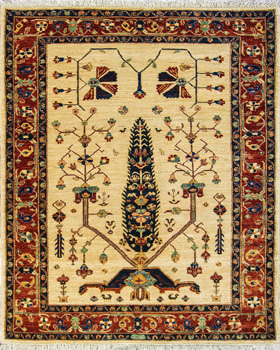Your wish list is empty.
Oriental Rugs » Symbols in Weaving
Symbols in Rug Weaving: Tree of Life
Submitted by Carolien van Straten, Co-Manager, The Magic Carpet

Tree of Life rug - Barakat project.
Since the beginning of time, man has found inspiration, consolation and guidance through symbols. Oriental rugs contain a wealth of symbols, expressing the culture and beliefs of the people who wove them. Although the range of symbols focus on aspects of daily life and the resources needed for survival, they are also filled with elements signifying worship and spiritual devotion. We find these symbols in rugs from Islamic, Christian, Buddhist and Hindu weaving cultures. All of them speak of human values, surrender and faith.
From antiquity, people’s deep spiritual connection to nature and high level of dependency on natural cycles, were expressed through symbols and incorporated into rug weaving motifs. We can find symbols for the sun, the moon, hunting scenes and gardens, all expressing reverence and gratitude for what nature has to offer. Through symbols, deities were honored and prayed to for rain, a bountiful harvest and happiness of family.
In this month’s article, we’d like to focus on one of the oldest and most profound symbols: the “Tree of Life.” As an ancient religious motif, this symbol is found throughout all of the world’s weaving cultures. The Tree of Life represents immortality, longevity and resurrection. In Biblical scenes, it stands for the Garden of Eden. In the Muslim carpet design, it represents Paradise, along with its fruit which signifies sustenance and abundance. In Chinese rugs, the Tree of Life symbolizes immortality.
A variety of trees were used in different rug weaving traditions, with a distinct development through time. The Tree of Life symbol found in both Persian and Indian rugs evolved from crude tree roots without leaves in around 1400 A.D., to elaborate flowering trees by 1600. Flowers in trees have been used as an uplifting symbol for people who live in arid environments. Common trees are the cypress, the cedar, the willow and the fig tree. While these trees symbolized immortality in the afterlife as well as divine power, by contrast, palm trees were metaphors for fulfillment and blessing. Persian palm trees represented fulfillment of secret wishes, while the coconut palm in India stood for the tree of requests. Whichever the tree, the designs ranged from elaborate and curvilinear to tribal and geometric, each expressive of their unique regional and ethnic tradition.
With its roots hidden in the ground, and upward rising branches, the Tree of Life represents the movement of consciousness from earthly to divine awareness. It was said that the good and just rose through the branches of trees and from the peaks of mountains up to heaven. Tree of Life rugs often had animal heads on top of the trees with different animals representing different virtues.
In contrast to its spiritual symbolism, the Tree of Life can also function as a representation of family cohesiveness, with the head of the family portrayed by the trunk of the tree, and offspring by the branches. This metaphor is the foundation of the “Family Tree” in the West.
Featured here is one of our Persian Qashqai design Tree of Life rugs, woven in Afghanistan, using hand carded and hand spun wool, and dyed with vibrant vegetable dyes. This rug has a cypress tree filled with stylized flowers and two birds. More Tree of Life motifs are in the field with more birds, and below the root structure are two peacocks. In the border, we can see one of the oldest symbols, the “boteh”, which represents, among other things, the eternal flame. It is shaped like the paisley design, a palm leaf, or a cashew nut.
The wealth of symbols found in the world of rug design adds to the mystique and captivating beauty of this art form. Our collection at The Magic Carpet reflects this ancient tradition and we welcome you to come and enjoy these wonderful examples of art underfoot in our shop or view our collection online.
The Magic Carpet will continue our monthly educational articles on the extraordinary art and history embodied by Oriental rugs. In our next article will be exploring the differences between tribal, village and classical rugs.


